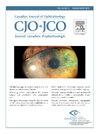左旋布比卡因与布比卡因在眼科手术中用于球周阻滞:一项系统综述和荟萃分析。
IF 2.8
4区 医学
Q1 OPHTHALMOLOGY
Canadian journal of ophthalmology. Journal canadien d'ophtalmologie
Pub Date : 2025-10-01
DOI:10.1016/j.jcjo.2025.02.011
引用次数: 0
摘要
目的:比较左布比卡因与布比卡因在眼科手术中治疗球周阻滞的疗效。方法:按照系统评价和元分析指南的首选报告项目进行系统评价和元分析。MEDLINE、EMBASE、EMCARE、CINAHL和Cochrane Central Register of Controlled Trials (Central)中比较左旋布比卡因和布比卡因在眼科手术中用于眼球周围阻滞的出版物从开始到2023年12月22日进行了筛选。我们的分析通过计算连续变量的平均差异(MD)和二分变量的优势比(OR)来总结,使用基于异质性水平的固定效应或随机效应荟萃分析。结果:在1998年至2023年间发表的英文文献中确定了8项随机对照试验,纳入了800名患者。2分钟时的运动障碍评分差异无统计学意义(MD = 0.17;p = 0.12)或注射后10分钟(MD = 0.02; = 0.89页)。同样,两组在麻醉效果起效时间上差异无统计学意义(MD = 0.38;p = 0.36),术后复视(OR = 0.62;p = 0.17),全身性低血压的发生率(OR = 1.00;p = 1.00)或阻滞期间言语疼痛量表(MD = 0.04;p = 0.66),手术结束时(MD = -0.01;p = 0.94)或术后4小时(MD = -0.00; = 0.98页)。结论:通过这项荟萃分析,我们得出结论,左旋布比卡因和布比卡因在运动障碍评分、麻醉效果发生时间、言语疼痛量表、术后复视或全身性低血压发生率方面没有显著差异。本文章由计算机程序翻译,如有差异,请以英文原文为准。
Levobupivacaine versus bupivacaine in peribulbar block for ophthalmic surgeries: a systematic review and meta-analysis
Objective
To compare the efficacy of levobupivacaine versus bupivacaine for peribulbar block in ophthalmic surgery.
Methods
A systematic review and meta-analysis were performed as per the Preferred Reporting Items for Systematic Reviews and Meta-analyses guidelines. Publications in MEDLINE, EMBASE, EMCARE, CINAHL, and the Cochrane Central Register of Controlled Trials (CENTRAL) that compared levobupivacaine and bupivacaine for peribulbar block in ophthalmic surgery were screened for eligibility from inception through December 22, 2023. Our analyses were summarized by calculating mean differences (MD) for continuous variables and odds ratios (OR) for dichotomous variables, using either fixed-effects or random-effects meta-analysis based on the level of heterogeneity.
Results
Eight randomized control trials enrolling 800 patients were identified in the English literature published between 1998 and 2023. There was no statistically significant difference in akinesia score at 2 minutes (MD = 0.17; p = 0.12) or 10 minutes postinjection (MD = 0.02; p = 0.89). Similarly, there was no statistically significant difference between the 2 groups in terms of time of onset of the anesthetic effect (MD = 0.38; p = 0.36), postoperative diplopia (OR = 0.62; p = 0.17), incidence of systemic hypotension (OR = 1.00; p = 1.00) or verbal pain scales during the block (MD = 0.04; p = 0.66), at the end of surgery (MD = −0.01; p = 0.94) or 4 hours postoperatively (MD = −0.00; p = 0.98).
Conclusions
As a result of conducting this meta-analysis, we conclude that there is no significant difference between levobupivacaine and bupivacaine in terms of akinesia score, time to onset of anesthetic effect, verbal pain scales, postoperative diplopia, or incidence of systemic hypotension.
Objectif
Comparer l’efficacité de la lévobupivacaïne à celle de la bupivacaïne pour réaliser une anesthésie péribulbaire en vue d’une chirurgie ophtalmologique.
Méthodes
On a procédé à une revue de synthèse systématique de même qu’à une méta-analyse conformément aux lignes directrices PRISMA (Preferred Reporting Items for Systematic Reviews and Meta-Analyses). On a vérifié l’admissibilité de tous les articles publiés dans MEDLINE, EMBASE, EMCARE, CINAHL et CENTRAL (Cochrane Central Register of Controlled Trials) comparant la lévobupivacaïne et la bupivacaïne dans l’anesthésie péribulbaire en vue d’une chirurgie ophtalmologique depuis la création des bases de données jusqu’au 22 décembre 2023. Nos analyses ont été résumées en calculant les différences moyennes (DM) pour variables continues et les rapports de cotes (RC) pour variables dichotomiques; on a eu recours à une méta-analyse à effets fixes ou à effets aléatoires selon le degré d’hétérogénéité des données.
Résultats
On a recensé, dans la littérature médicale anglophone, 8 études comparatives randomisées regroupant 800 patients qui ont été publiées entre 1998 et 2023. Aucune différence statistiquement significative n’a pu être dégagée quant au score d’akinésie, que ce soit 2 minutes (DM = 0,17; p = 0,12) ou 10 minutes après l’injection (DM = 0,02; p = 0,89). De même, on n’a enregistré aucune différence statistiquement significative entre les 2 groupes pour ce qui est du temps écoulé avant l’effet anesthésique (DM = 0,38; p = 0,36), de la diplopie postopératoire (RC = 0,62; p = 0,17), de l’incidence d’hypotension systémique (RC = 1,00; p = 1,00) ou des scores sur les échelles verbales simples pendant l’anesthésie (DM = 0,04; p = 0,66), que ce soit à la fin de l’intervention (DM = −0,01; p = 0,94) ou 4 heures après cette dernière (DM = −0,00; p = 0,98).
Conclusions
Notre méta-analyse nous a permis de conclure à l’absence de différence significative entre la lévobupivacaïne et la bupivacaïne pour ce qui est du score d’akinésie, du temps écoulé avant l’effet anesthésique, des scores sur les échelles verbales simples, de la diplopie postopératoire ou de l’incidence d’hypotension systémique.
求助全文
通过发布文献求助,成功后即可免费获取论文全文。
去求助
来源期刊
CiteScore
3.20
自引率
4.80%
发文量
223
审稿时长
38 days
期刊介绍:
Official journal of the Canadian Ophthalmological Society.
The Canadian Journal of Ophthalmology (CJO) is the official journal of the Canadian Ophthalmological Society and is committed to timely publication of original, peer-reviewed ophthalmology and vision science articles.

 求助内容:
求助内容: 应助结果提醒方式:
应助结果提醒方式:


